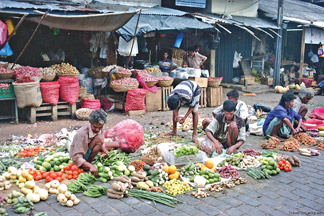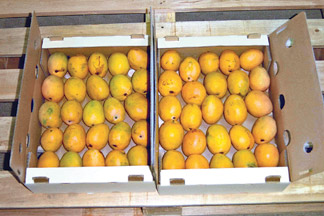|
Post-harvest wastage causes high prices:
Corrugated packaging for veggies - ideal solution
By Dhaneshi YATAWARA
 According to statistics that whirled around the world in 2009 about
one billion earth dwellers suffer from hunger. Out of this nearly 642
million people are in the Asian and Pacific regions. The Food and
Agriculture Organisation of the United Nations has estimated that
considering the world food production there is enough food in the world
to feed every earth dweller with at least 2720 kilo calories per person
per day. The real problem lies mainly with the domestic level food
insecurity and low ability of the people to purchase food. Isn't
everyone complaining about the thundering market prices of the humble
vegetable? But rarely anyone would seek for the real reason. Lately the
focus was on transportation methods of vegetables and fruits. Government
concern in trying to impose standards and regulations is a positive
approach in protecting the rights of the consumer. According to statistics that whirled around the world in 2009 about
one billion earth dwellers suffer from hunger. Out of this nearly 642
million people are in the Asian and Pacific regions. The Food and
Agriculture Organisation of the United Nations has estimated that
considering the world food production there is enough food in the world
to feed every earth dweller with at least 2720 kilo calories per person
per day. The real problem lies mainly with the domestic level food
insecurity and low ability of the people to purchase food. Isn't
everyone complaining about the thundering market prices of the humble
vegetable? But rarely anyone would seek for the real reason. Lately the
focus was on transportation methods of vegetables and fruits. Government
concern in trying to impose standards and regulations is a positive
approach in protecting the rights of the consumer.
 Though being a land of farmers and with a long standing agriculture
history, Sri Lanka, strangely, lacks an evenly distributed diversity of
vegetables and fruits in the market. There could be problems with the
supply as well as the demand. What needs to be done right now is the
question? This was much discussed at the recently held Global Forum for
Sri Lankan Scientists organized by the Ministry of Technology and
Research. Scientists don't give an alarming situation of food security
in Sri Lanka. Yet the high prices of vegetables do create a problem and
as identified waste of vegetables due to improper transportation causes
much of the problem. It is a problem created due to the lack of
practical approach to proper post harvest techniques. Though being a land of farmers and with a long standing agriculture
history, Sri Lanka, strangely, lacks an evenly distributed diversity of
vegetables and fruits in the market. There could be problems with the
supply as well as the demand. What needs to be done right now is the
question? This was much discussed at the recently held Global Forum for
Sri Lankan Scientists organized by the Ministry of Technology and
Research. Scientists don't give an alarming situation of food security
in Sri Lanka. Yet the high prices of vegetables do create a problem and
as identified waste of vegetables due to improper transportation causes
much of the problem. It is a problem created due to the lack of
practical approach to proper post harvest techniques.
 "In Sri Lanka we see a huge post harvest wastage in vegetables and
fruits. Yet this is multi-disciplinary situation," said Dr. Shanthi
Wilson, Additional Director (Research and Development) of the Industrial
Technology Institute. "Techniques should focus on preventing loss due to
physical injury and this includes several components," Dr. Wilson added.
She further explained that minimizing vibration in transporting
vehicles, using cushioning material for fruits and vegetables, using
proper harvesting tools and harvesting at the correct time - all
contribute to prevent the loss at the end that would burden the
consumer. "Many of these vehicles that transport vegetables need to
travel on bumpy roads and looking at the suspensions of these vehicles
and if they are not working properly it would also lead to damaging the
harvest. Thus it is essential to maintain these vehicles properly," she
added. "In Sri Lanka we see a huge post harvest wastage in vegetables and
fruits. Yet this is multi-disciplinary situation," said Dr. Shanthi
Wilson, Additional Director (Research and Development) of the Industrial
Technology Institute. "Techniques should focus on preventing loss due to
physical injury and this includes several components," Dr. Wilson added.
She further explained that minimizing vibration in transporting
vehicles, using cushioning material for fruits and vegetables, using
proper harvesting tools and harvesting at the correct time - all
contribute to prevent the loss at the end that would burden the
consumer. "Many of these vehicles that transport vegetables need to
travel on bumpy roads and looking at the suspensions of these vehicles
and if they are not working properly it would also lead to damaging the
harvest. Thus it is essential to maintain these vehicles properly," she
added.
The other aspect would be to look at using cushioning material while
transporting," she added. According to Dr. Wilson the ITI is carrying
out researches in collaboration with foreign universities to find out
ways and means of proper transport of fruits and vegetables. It was
highlighted that using corrugated packaging would be an ideal solution.
This would suit the trade as these cardboard boxes can be discarded when
the goods are transported to the retail market. The problem that
transporters raised when the request came to use plastic crates was that
the hindrance to their business venture on return. If the packaging is
of bio degradable material it can be properly disposed without damaging
the environment and giving space to the business as well.
Other than this, farmers' harvesting practices also matter in
reducing post harvest loss, as she further explained. "As we don't have
very large scale cultivations it will be difficult for the farmers to
use hi tech harvesting machines but at least to an extent it should
happen. This must be implemented even at the few large scale
cultivations we have in Sri Lanka mainly owned by the private
sector,"she added. The farmers should be knowledgeable in maturity
indices of fruits and vegetables so as to harvest on correct time - not
too raw or not too ripe. Though we are not a big country it does take
few days for the vegetables and fruits to reach the consumer from the
time of harvest. Thus it is essential to have a mechanism to keep the
maturing process of fruits and vegetables inhibited until it reaches its
destination. Edible wax that is used to cover these fruits and
vegetables is a popular solution. In Sri Lanka what inhibits farmers and
traders in this business from buying this is that so far we only had the
imported wax that was quite expensive.

 Industrial Technology Institute has invented a new variety of edible
wax that could be used to preserve and protect fruits and vegetables
more effectively to keep them fresh during the journey from the farm to
the household. "These edible waxes are not harmful to the people. It
only covers the fruit or the vegetable and keeps it in its original
state until it reaches the consumer," Dr. Wilson explained. The product
can also delay the natural process of fruit ripening. It can be applied
after the harvest, prior to sending them to distribution centres.
According to her post harvest diseases also play a major role to the
loss. These diseases are aggravated with the physical loss to the goods.
Anthracnose and stem end rot are major post harvest diseases that can be
found mainly in tropical fruits. The new wax will minimise damage during
transportation, preserve the products for long hours and prevent damage
due to such micro-organisms. Another method would be to use biological
agents as controls to such pathogens - one such bio tool is yeast.
Though still under research it is found that Fungi can be used as a
biological control. In Sri Lanka tests for all these aspects have given
promising results to papaya, king coconut, pineapple and mangoes. The
cold wax treatment is used especially in the export sector but this can
be transferred to the local business sector too. Industrial Technology Institute has invented a new variety of edible
wax that could be used to preserve and protect fruits and vegetables
more effectively to keep them fresh during the journey from the farm to
the household. "These edible waxes are not harmful to the people. It
only covers the fruit or the vegetable and keeps it in its original
state until it reaches the consumer," Dr. Wilson explained. The product
can also delay the natural process of fruit ripening. It can be applied
after the harvest, prior to sending them to distribution centres.
According to her post harvest diseases also play a major role to the
loss. These diseases are aggravated with the physical loss to the goods.
Anthracnose and stem end rot are major post harvest diseases that can be
found mainly in tropical fruits. The new wax will minimise damage during
transportation, preserve the products for long hours and prevent damage
due to such micro-organisms. Another method would be to use biological
agents as controls to such pathogens - one such bio tool is yeast.
Though still under research it is found that Fungi can be used as a
biological control. In Sri Lanka tests for all these aspects have given
promising results to papaya, king coconut, pineapple and mangoes. The
cold wax treatment is used especially in the export sector but this can
be transferred to the local business sector too.
According to Dr. D.G. Jayawardane's presentation at the Global Forum
for Sri Lankan Scientists, Sri Lanka is self sufficient in many
products. For rice in 2010 the per capita consumption has been around
109 kilograms per year and that year per capita availability of rice has
been 127 kilograms per year. We are 65% self sufficient in Kurakkan
(bran) production. Cowpea it is 95% self sufficiency. With vegetables,
Dr. Jayawardane explained that Sri Lanka has hardly any imports - we are
on an average 60% self sufficient in vegetables. In fruits, though it
depends on the season Sri Lanka imports only a portion which includes
fruits that grow in temperate regions. In such a situation Sri Lanka
shows a great potential to further grow in this field of market with
more value added productions. With the local knowledge base Sri Lanka
has come up with enough and more solutions to post harvest problems. The
Vidatha centres established under the Ministry of Technology and
Research have been a great resource for these scientists to transfer
this knowledge to the farmers. At this moment it is essential to expand
the receiving group and include all sectors involved in fruit and
vegetable business at all levels from the farm to the household. This is
so because at the the end it is the entire populace of the country will
be benefited with good quality healthy food at a reasonable price. |

